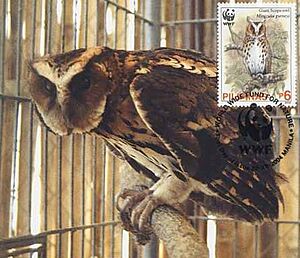Giant scops owl facts for kids
Quick facts for kids Giant scops owl |
|
|---|---|
 |
|
| Otus gurneyi on a 2004 stamp and postcard of the Philippines | |
| Conservation status | |
| Scientific classification | |
| Genus: |
Otus
|
| Species: |
gurneyi
|
| Synonyms | |
|
|
The giant scops owl (Otus gurneyi) is a special type of owl. People also call it the lesser eagle-owl or the Mindanao eagle-owl. This owl lives only in the Philippines. It looks like a mix between a smaller scops owl and a larger eagle-owl. It loves living in warm, wet forests. Sadly, its home is shrinking, which puts it in danger.
Contents
Understanding the Giant Scops Owl's Name
Every living thing has a scientific name. This helps scientists around the world know exactly which animal they are talking about. The giant scops owl was first given a different name. It was called Pseudoptynx gurneyi. Later, it was known as Mimizuku gurneyi. Now, it is part of the Otus group. This group includes many types of scops owls.
What Does the Giant Scops Owl Look Like?
The giant scops owl is a medium-sized bird. It is about 30 cm (12 in) long. That's about the length of a school ruler! It has a reddish-brown face. This face disc has a thin black edge. You can see white lines above its eyes. It also has very noticeable ear tufts. These tufts look like little horns on its head.
The back of its head and its upper body are reddish-brown. They have bold black stripes. There is also a line of white stripes on its shoulders. Its belly and chest are whitish. They have some reddish-brown spots and strong black marks.
What about its voice? The giant scops owl makes a series of calls. It sounds like "wuaah, wuaah...". It usually makes five to ten of these calls in a row. Then, it repeats the whole series after ten to twenty seconds.
Where Do Giant Scops Owls Live?
The giant scops owl is found only in the Philippines. It lives on a few islands there. These islands are Dinagat, Siargao, and Mindanao. Some people think these owls might also live on Marinduque island. Marinduque is off the coast of Luzon island. But this has not been proven yet.
These owls live in both old and new forests. They usually live in places below 670 m (2,200 ft) high. But sometimes, they have been seen higher up. They can be found at altitudes of up to 1,300 m (4,300 ft). They sometimes visit forests that have been partly cut down. Especially if these forests have Dipterocarpaceae trees.
Protecting the Giant Scops Owl
The giant scops owl is in trouble. The IUCN (International Union for Conservation of Nature) lists it as "Vulnerable". This means it is at high risk of becoming endangered. Its numbers are going down. This is because its forest home is being destroyed. People are cutting down trees (deforestation). They are also digging for minerals like chromite. This mining also harms the forests.
This owl was never a very common bird. In 1999, experts thought there were only a few thousand left. Most of the forests on Dinagat island are now gone. On Samar and Mindanao, many remaining forests are used by mining or logging companies.
But there is hope! A group called "Endangered Species International" is helping. They use this owl and other rare animals. They have a special trail in the Mount Matutum protected area. Here, they teach local people and visitors about protecting nature. They show why it is so important to save the owl's home.



